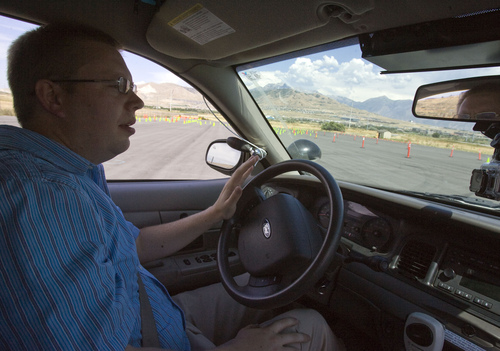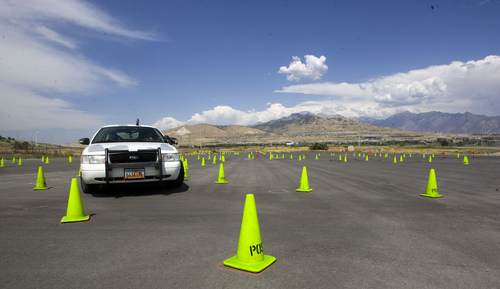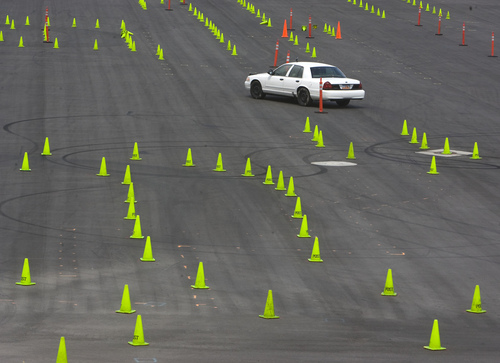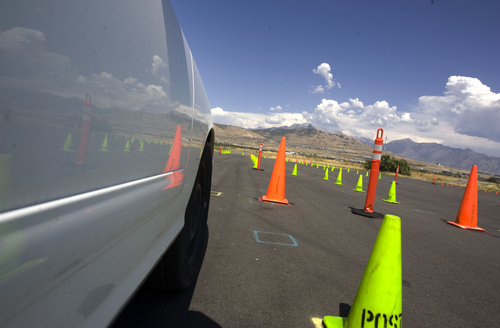This is an archived article that was published on sltrib.com in 2013, and information in the article may be outdated. It is provided only for personal research purposes and may not be reprinted.
Lehi • Nate Davis had only backed up a few inches when there was a low thud against the against the back of his Crown Victoria. After several seconds, Davis looked in his rear view mirror, then hit the gas and kept driving. Before long, there were more thuds as Davis bumped other obstacles in the narrow lanes he was navigating.
But while Davis was clearly having some trouble driving, he wasn't drunk or just careless. Instead, he was demonstrating the dangers of drowsy driving.
Davis was one of three people who stayed up all night Tuesday, then arrived Wednesday afternoon at the Department of Public Safety's driving range. One by one, Davis and the other drivers climbed into an old police car and tried to navigate a series of tight curves marked with orange and green cones.
The event was organized by the Utah Department of Transportation and DPS. During the demonstration, UDOT spokeswoman Tania Mashburn said the summer months are the most deadly on Utah roads. So far this year, there have been eight deaths in Utah that were clearly due to drowsy diving. Usually, Mashburn added, Utah has about 18 deaths per year that result from drowsy driving, which she added is under-reported and may be a factor in even more accidents.
Mashburn added that driving after being awake for even 20 hours is the equivalent of having a .08 blood alcohol level, or being legally drunk.
When Davis sat behind the wheel, he had been awake for about 30 hours. He started by backing up — which is when he bumped his first cones — then proceeded to swerve and back up as he approached obstacles designed to replicated a neighborhood driving setting and force drivers to think ahead.
"It's a lot tougher to concentrate," Davis said as he spun the steering wheel. "Interpreting what's coming next is what's getting me."
Afterward, Davis said he felt sluggish and that driving was more difficult. Everything "felt slow" and he was forced to "think twice" about the decisions he was making. Davis said the experience taught him that he needs to take breaks on longer drives and look for the signs of drowsy driving.
Lindsey Tait, 17, also tried to navigate the course after a night with no sleep. Tait, who has had her license for about a year, said she was surprised at how hard it was to turn the steering wheel and stay focused. And though she kept a relatively slow speed the entire time, Tait expressed surprise at how her perceptions changed.
"It felt like I was going 100 mph," she said afterward.
Mashburn grouped drowsy driving with four other high-risk, behind-the-wheel behaviors: drunk driving, aggressive driving, distracted driving and not buckling up. Data provided by UDOT indicates that drivers 25-years-old or younger are involved in nearly half of all drowsy driving accidents. Males are 2.8 times more likely to be involved in a drowsy driving crash, and Millard and Emery counties had the highest percent of accidents in 2012.
After the demonstration ended, Kylie LaLumia, the third driver who stayed up all night to participate, said the hardest parts of driving the course were backing up and making sharp turns. More importantly, she said, the experience prompted her to be careful in the future.
"You're not just putting you own life at risk," LaLumia added, "you're putting everyone else at risk too."
For more information on the signs and dangers of drowsy driving, visit www.sleepsmartdrivesmart.com">http://www.sleepsmartdrivesmart.com and ut.zerofatalities.com.
Twitter: @jimmycdii —
2012 Utah Drowsy Driving Facts
Young drivers age 25 or under were involved in nearly 43 percent of all drowsy driving crashes.
Male drivers were 2.8 times more likely to be in drowsy driver crashes.
The hours of 6 to 8:50 a.m. had the highest number of drowsy driver crashes.
May and July had the highest number of drowsy driving crashes.
Millard and Emery counties had the highest percent of crashes involving drowsy drivers.
Crashes in rural counties in Utah were 2.5 times more likely to involve drowsy driving than crashes in urban counties.











